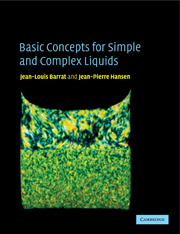Preface
Published online by Cambridge University Press: 06 January 2010
Summary
While the solid state of matter is mostly associated with the mineral world and much of modern technology, liquids are more closely related to living matter and biological processes. In fact life is generally believed to have emerged in the primordial ocean which was formed when the right temperature conditions came to prevail on the young Earth, providing a striking illustration of the ‘marginal’ character of the liquid state, compared to the solid and gaseous phases of the same substances, which exist over much wider ranges of temperature and pressure. The liquid state arises from a delicate balance between ‘packing’ of molecules and cohesive forces or, more formally, between entropy and energy, which renders a statistical description very difficult, due to the absence of any obvious ‘small parameter’. This may explain that, while the gaseous and crystalline states of matter were well understood by the 1950s, significant theoretical progress on the liquid state only just started around that time, and was then speeded up by early neutron scattering and computer simulation data.
From the start, the exploration of the liquid state was interdisciplinary par excellence, thanks to the combined efforts of physicists, physical chemists and chemical engineers. However, early theoretical work evolved along two lines of thought. ‘Simple’ liquids were studied on a molecular scale, using statistical mechanics and computer simulations as basic tools, while ‘complex’ fluids (sometimes referred to as ‘soft matter’ following P.G. de Gennes) were mostly examined on a more coarse-grained level, epitomized in the scaling approach to the theory of polymer solutions.
- Type
- Chapter
- Information
- Basic Concepts for Simple and Complex Liquids , pp. ix - xiiPublisher: Cambridge University PressPrint publication year: 2003

